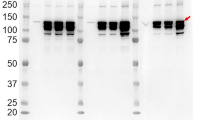Abstract
There have been conflicting reports about the occurrence and/or activity of atrial natriuretic peptide (ANP) sensitive guanylyl cyclase in the immune system. This study reports on ANP-sensitive guanylyl cyclase mRNA expression and guanylyl cyclase activity in human peripheral blood mononuclear cells (PBMC). Reverse transcription polymerase chain reaction (RT-PCR) shows that activated human PBMC of healthy blood donors express functional active ANP-sensitive guanylyl cyclase after vitro culture, whereas freshly isolated PBMC show neither specific mRNA for particulate guanylyl cyclase nor ANP-sensitive activity of this enzyme. To define the subpopulation of PBMC expressing this enzyme, cultivated PBMC were subfractioned and analyzed by RT-PCR and in situ PCR. Only CD3+ PBMC showed mRNA for ANP-sensitive guanylyl cyclase. Induction of the guanylyl cyclase required coincubation with other cells, indicating that a factor or factors secreted from cells other than CD3+ cells induces this expression. In summary, ANP-sensitive guanylyl cyclase is an inducible enzyme in human CD3+ PBMC in contrast to other cells where it is considered to be constitutive.
Similar content being viewed by others
Author information
Authors and Affiliations
Additional information
Received: 19 January 1996 / Accepted: 11 July 1996
Rights and permissions
About this article
Cite this article
Heim, JM., Knau, B., Sturm, C. et al. Particulate ANP-sensitive guanylyl cyclase: induction in cultured human peripheral CD3+ mononuclear blood cells. J Mol Med 74, 629–635 (1996). https://doi.org/10.1007/s001090050067
Issue Date:
DOI: https://doi.org/10.1007/s001090050067




